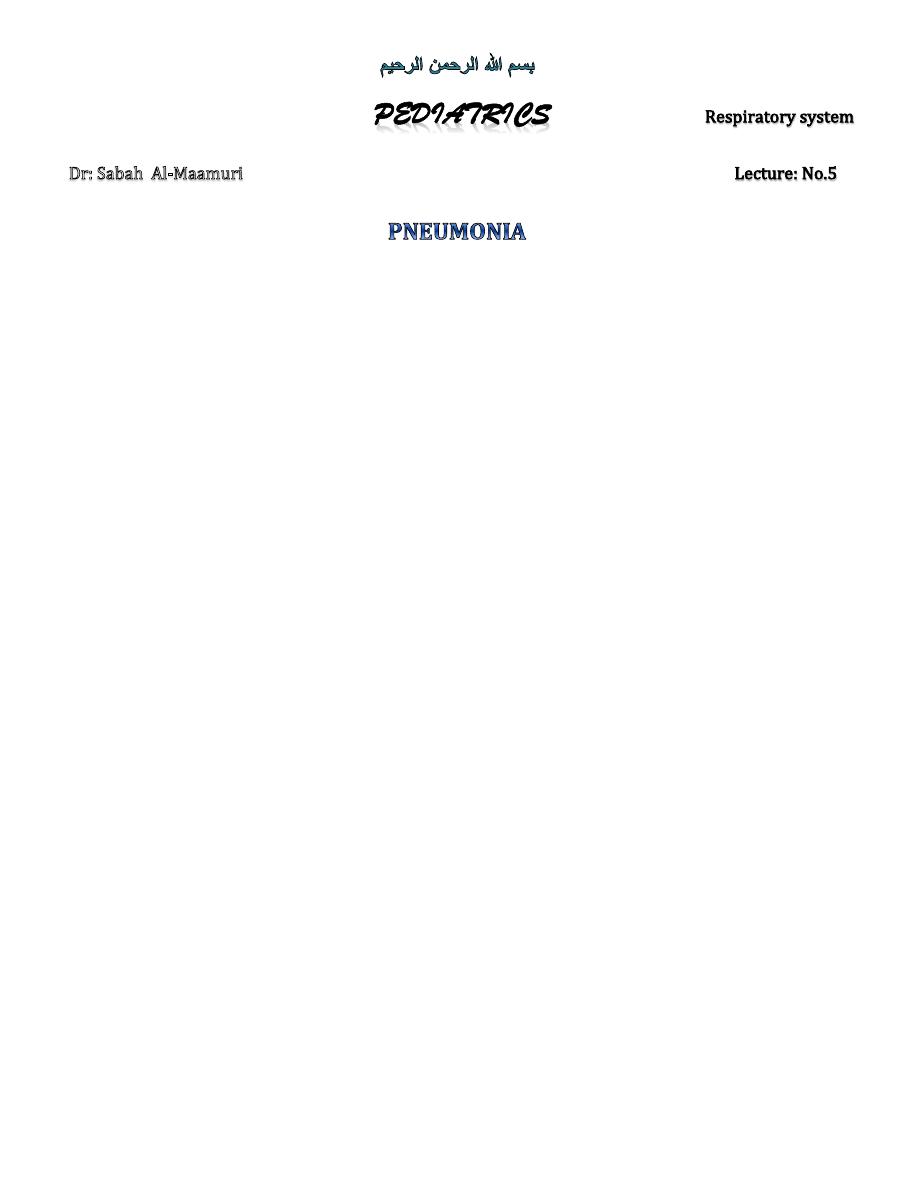
1
Pneumonia is an inflammation of the paranchyma of the lungs.
It is a significant cause of mortality in childhood throughout the world, particularly in the developing
countries, pneumonia is estimated to cause ≈3 million deaths, or an estimated 29% of all deaths, among
children younger than 5 yr worldwide.
The incidence of pneumonia is more than 10-fold higher
and the
number of childhood-related deaths due to pneumonia ≈2000-fold higher, in developing than in developed
countries
Etiology
pneumonia are caused by microorganisms, noninfectious causes include aspiration of food or gastric acid,
foreign bodies, hydrocarbons, and lipoid substances, hypersensitivity reactions, and drug- or radiation-induced
pneumonitis. The cause of pneumonia in an individual patient is often difficult to determine because direct culture
of lung tissue is invasive and rarely performed.
1.
Bacterial or viral cause of pneumonia can be identified in 40-80% of children with community-acquired
pneumonia.
Streptococcus pneumoniae (pneumococcus) is the most common bacterial pathogen in children 3 wk to 4 yr of
age, whereas Mycoplasma pneumoniae and Chlamydophila pneumoniae are the most frequent pathogens in
children 5 yr and older. In addition to pneumococcus, other bacterial causes of pneumonia include group A
streptococcus (Streptococcus pyogenes) and Staphylococcus aureus
.
2.
Viral pathogens are a prominent cause of lower respiratory tract infections in infants and children <5 yr of
age. Viruses are responsible for 45% of the episodes of pneumonia
,
more common in the fall and winter
influenza viru), and respiratory syncytial virus (RSV) are the major pathogens, especially in children <3 yr of age.
Other common viruses causing pneumonia include parainfluenza viruses, adenoviruses, rhinoviruses, and human
metapneumovirus.
3. Atypical pneumonias caused by Mycoplasma pneumonia & Chlamydia pneumonia are more
prevalent in school aged children & older children.
Specific risk factors for development of pneumonia
1. Lung diseases as asthma or cystic fibrosis.
2. Anatomic problems as tracheoesoophageal fistula.
3. Gastroesophageal reflux disease (GERD) with aspiration.
4. Neurologic disorders which interfere with protection of the airways or compromise clearing of the
airways.
5. Diseases which alter the immune system as immunodeficiency or hemoglobinopathies.
6. Season ( ↑in fall & winter).
7. Viral infections of the respiratory tract can predispose to the 2ry bacterial infections by disturbing the
normal host defense mechanisms, altering secretions, & modifying bacterial flora.
Recurrent pneumonia
Defined as 2 or more episodes in a single year or 3 or more episodes ever, with radiographic clearing
between occurrences.

2
Causes of recurrent pneumonia
1. Aspiration susceptibility : Oropharyngeal incoordination, Vocal cord paralysis, GERD.
2. Immunodeficiency : Congenital & acquired.
3. Congenital cardiac defects : ASD, VSD, PDA.
4. Abnormal secretions or ↓clearance of secretions : Asthma, Cystic fibrosis, Ciliary
dyskinesia.
5. Pulmonary anomalies : Sequestrations, Cystic adenomatoid malformation, TEF .
6. Airway compression or obstruction : Foreign body, Vascular ring, Enlarged lymph node,
Malignancy.
7. Miscellaneous : e.g. Sickle cell anemia & Sarcoidosis.
Clinical presentations
Viral pneumonias
Viral and bacterial pneumonias are often preceded by several days of symptoms of an upper
respiratory tract infection, typically rhinitis and cough. In viral pneumonia, fever is usually present;
temperatures are generally lower than in bacterial pneumonia. Tachypnea is the most consistent clinical
manifestation of pneumonia. Increased work of breathing accompanied by intercostal, subcostal, and
suprasternal retractions, nasal flaring, and use of accessory muscles is common. Severe infection may be
accompanied by cyanosis and respiratory fatigue, especially in infants. Auscultation of the chest may
reveal crackles and wheezing, but it is often difficult to localize the source of these adventitious sounds
in very young children with hyperresonant chests. It is often not possible to distinguish viral pneumonia
clinically from disease caused by Mycoplasma and other bacterial pathogens.
Bacterial pneumonia
in adults and older children typically begins suddenly with a shaking chill followed by a high fever,
cough, and chest pain. Other symptoms that may be seen include drowsiness with intermittent periods of
restlessness; rapid respirations; anxiety; and, occasionally, delirium. Circumoral cyanosis may be
observed. In many children, splinting on the affected side to minimize pleuritic pain and improve
ventilation is noted; such children may lie on one side with the knees drawn up to the chest.
Physical findings
Depend on the stage of pneumonia.
Early findings may include ↓ breath sounds, scattered crackles & rhonchi on the affected side. with
increasing consolidation or with complications as pleural effusion, empyema, or pneumothorax →
dullness on percussion & ↓breath sounds. abdominal distention may be prominent due to gastric dilation
from swallowed air &/or ileus.The liver may seem enlarged due to downward displacement of the
diaphragm 2ry to hyperinflation of the lungs or superimposed congestive heart failure (CHF). There may
be nuchal rigidity (in the absence of meningitis) especially with right upper lobe pneumonia.
In infants
The clinical patterns are more variable. There may be a prodrome of URTI & ↓appetite followed by an
abrupt onset of fever , restlessness, apprehension, & respiratory distress. These infants appear ill with
respiratory distress (grunting, nasal flaring, retractions of the supraclavicular, intercostals, & subcostal
areas, tachypnea, tachycardia, air hunger, & often cyanosis). Results of physical examination may be

3
misleading especially in young infants who may have associated GIT disturbances(vomiting, anorexia,
diarrhea, & abdominal distention).
Rapid progression of symptoms is characteristic in the most severe cases of bacterial pneumonia.
Atypical pneumonia
Often caused by mycoplasma pneumonia or viral infections. The infections tend to start gradually,
have minimal or non-productive cough, & have frequent constitutional symptoms as rash, headache,
pharyngitis, & GIT symptoms. CXR tend to show patchy , peribronchial infiltrate with only occasional
lobar consolidation.
Afebrile infant pneumonia
Caused by Chlamydia trachomatis, CMV, ureaplasma urealyticum, or mycoplasma hominis. Affected
infants develop progressive respiratory distress over several days to few weeks associated with failure to
thrive (FTT). A maternal history of sexually transmitted disease is common. CXR →bilateral diffuse
infiltrate with hyperinflation. There may be esinophilia & ↑immunoglobulins (Ig G, A,& M). The causes
overlap clinically, although a history of conjunctivitis suggests Chlamydial infection.
Diagnosis
1. CXR : to confirm the diagnosis & exclude complications as pleural effusion, pneumothorax, or
empyema.
In viral pneumonia →hyperinflation + bilateral interstitial infiltrates & peribronchial cuffing.
In bacterial pneumonia →confluent lobar consolidation is typically seen with pneumococcal
pneumonia.
The radiographic appearance alone is not diagnostic & CXR cannot reliably distinguish between
bacteria & viral pneumonia. Radiographic findings resolve in variable times according to the
causative agents (pneumococcus in 6-8 wk, RSV in 2-3 wk, adenovirus may take 1 yr to resolve). If
significant radiological abnormalities persist > 6 wk, there should be a high index of suspicion for
a possible underlying problem (e.g. unusual infections, anatomic abnormality, or
immunodeficiency).
Follow-up CXR in pneumonia are generally not indicated except in children with pleural effusion,
persistent or recurrent signs or symptoms with co morbid conditions (e.g. immunodeficiency).
2. WBC count may be useful in differentiating viral from bacterial pneumonia. In viral pneumonia
→WBC count may be normal or ↑but usually not > 20,000/mm
3
with alymphocyte predominance.
In bacterial pneumonia →WBC count is often ↑(15,000 –40,000/mm
3
) with a granulocyte
predominance.
3. The definitive diagnosis of a viral infections rests on the isolation of the virus or the detection of
the viral antigen in the respiratory tract secretions. Tissue cultures require 5 -10 days. Serologic
techniques may be used to diagnose a recent viral infection but generally require testing of the
acute & convalescent serum samples for ↑antibodies to a specific viral agent (epidemiologic tool).
4. The definitive diagnosis of a bacterial infection requires isolation of the organism from the blood
(≤10% with bacterial pneumonia), from the pleural fluid (60-85%), or from lungs. Sputum culture
is of no value ( due to carrier states in healthy children, e.g. staphylococcus aureus or H. influenza
).
5. In mycoplasma pneumonia →↑cold agglutinin titers > 1:64 is found in 50% of cases but it is not
specific ( may ↑with other infection as influenza viral infection).
6. In group A streptococcus pneumonia →↑ASO titer.

4
Treatment
Treatment of suspected bacterial pneumonia is based on the presumptive cause and the age and clinical
appearance of the child. For mildly ill children who do not require hospitalization, amoxicillin is recommended. In
communities with a high percentage of penicillin-resistant pneumococci, high doses of amoxicillin (80-
90 mg/kg/24 hr) should be prescribed. Therapeutic alternatives include cefuroxime axetil and
amoxicillin/clavulanate. For school-aged children and in children in whom infection with M. pneumoniae or C.
pneumoniae is suggested, a macrolide antibiotic such as azithromycin is an appropriate choice. In adolescents, a
respiratory fluoroquinolone (levofloxacin, moxifloxacin, gemifloxacin) may be considered as an alternative.
If viral pneumonia is suspected, it is reasonable to withhold antibiotic therapy, especially for those
patients who are mildly ill, have clinical evidence suggesting viral infection, and are in no respiratory
distress. Up to 30% of patients with known viral infection may have coexisting bacterial pathogens.
Therefore, if the decision is made to withhold antibiotic therapy on the basis of presumptive diagnosis of
a viral infection, deterioration in clinical status should signal the possibility of superimposed bacterial
infection, and antibiotic therapy should be initiated.
Indications for hospital management
1. Age <6 mo
2. Sickle cell anemia with acute chest syndrome
3. Multiple lobe involvement
4. Immunocompromised state
5. Toxic appearance
6.Moderate to severe respiratory distress
7.Requirement for supplemental oxygen
8.Dehydration
9.Vomiting or inability to tolerate oral fluids or medications
10.No response to appropriate oral antibiotic therapy
11.Social factors (e.g., inability of caregivers to administer medications at home or follow up
appropriately)
Hospital management
1. Close observation :
Frequent monitoring of the degree of respiratory distress is essential. The respiratory rate,
retractions, grunting, color, & level of consciousness should be recorded every 1-2 hr.
2. O2 therapy :
The presence of respiratory distress is an indication of O2 therapy. The method of administration
depends on the age & patient tolerance ( infants →head box, older children →O2 mask or nasal prongs ).
O2 concentration depends on the degree of respiratory distress & the level of PaO2. Practically, 40-60%
O2 concentration is usually sufficient & the subsequent changes will depends on the course of the illness.
O2 should be used continuously & should be withdrawn gradually.

5
3. Antibiotics :
The empiric treatment of suspected bacterial pneumonia in a hospitalized child requires an approach
based on the clinical manifestations at the time of presentation. Parenteral cefotaxime or ceftriaxone is
the mainstay of therapy when bacterial pneumonia is suggested. If clinical features suggest
staphylococcal pneumonia (pneumatoceles, empyema), initial antimicrobial therapy should also include
vancomycin or clindamycin.
4. IV fluid :
In infants with moderate-severe respiratory distress, oral feeding is hazardous & may →serious
complications. Maintenance IV fluid is usually needed during the 1
st
2-3 days to provide an adequate fluid
intake. If the patient is still having a significant distress, NG tube feeding should be gradually replace the
IV fluid. Oral feeding can be resumed in patients with minimal or no distress.
5. Complication:
o
Pleural effusion & empyema :
Pleural effusion most often occur with pneumococcal pneumonia. Patients respond poorly to
treatment of pneumonia & develop worsening respiratory distress & chest pain or discomfort. CXR
shows the presence of fluid in the pleural space, a finding that can be confirmed on U/S. Most
effusions can be treated conservatively as they are small sterile parapneumonic collections of straw
colored fluid. Some clinicians advocate a tap of the pleural fluid to assess its consistency & for
diagnostic purposes. Closed intercostals drainage (underwater seal) is indicated in massive or
moderate effusion & the tube is left in place until complete drainage & complete expansion of the
collapsed lung which is usually achieved within 2-5 days. If the fluid proves to be frankly infected
then an empyema has occurred with active infection in the pleural space. Staphylococcus aureus &
streptococcus pneumonia are the most common causes of empyema. The treatment of empyema
depends on its stage weather it is exudative, fibrinopurulent, or organizing. Imaging studies including
U/S & CT- scan are helpful in determining the stage of empyema. The mainstays of treatment include
antibiotics therapy & drainage with tube thoracostomy. Newer approaches include fibrinoltytic
therapy & selected thoracoscopy to debride, lyse adhesions, & drain the loculaed areas of pus. Early
diagnosis & treatment may obviate the need for thoracotomy & open debridement.
o
Respiratory failure :
Fortunately, most cases of pneumonia with respiratory failure respond to management & recover
completely in 7-10 days. In severe cases of bronchopneumonia in infants, assisted mechanical
ventilation may be live-saving. The clinical criteria to initiate mechanical ventilation are cyanosis ( in
spite of 60% O2 ) or progressive deterioration of the level of consciousness. On the laboratory level,
O2 saturation < 90% or PaO2 < 50 mmHg (with 60% O2) or PaCO2 > 60 mmHg are indications for
mechanical ventilation. When facilities for intensive care are notavailable, manual ventilation with
bag & mask is an alternative.
o
Congestive heart failure (CHF) :
Myocarditis & CHF may occur especially in infants with severe bacterial bronchopneumonia.
Treatment include digoxin & diuretics. The fluid intake should be ↓about 20-30%.
o
Paralytic ileus :
severe pneumonia is the commonest cause of reflux ileus in infants which →vomiting & abdominal
distention. Plain abdominal X-rays in erect position → multiple fluid levels. The patient should be kept
on maintenance IV fluid with complete rest of the GIT. The condition usually subsides within few days
& gradual oral feeding can be resumed.

6
Typically, patients with uncomplicated community-acquired bacterial pneumonia respond to therapy
with improvement in clinical symptoms (fever, cough, tachypnea, chest pain) within 48–96 hr of
initiation of antibiotics. Radiographic evidence of improvement substantially lags behind clinical
improvement. A number of factors must be considered when a patient does not improve on appropriate
antibiotic therapy
(slowly resolving pneumonia):
(1) complications, such as empyema;
(2) bacterial resistance;
(3) nonbacterial etiologies such as viruses and aspiration of foreign bodies or food;
(4) bronchial obstruction from endobronchial lesions, foreign body, or mucous plugs;
(5) pre-existing diseases such as immunodeficiencies, ciliary dyskinesia, cystic fibrosis, pulmonary
sequestration, or cystic adenomatoid malformation; and
(6) other noninfectious causes (including bronchiolitis obliterans, hypersensitivity pneumonitis,
eosinophilic pneumonia, aspiration, and Wegener granulomatosis). A repeat chest x-ray is the 1st step in
determining the reason for delay in response to treatment.
Complications
usually due to direct spread of bacterial infections within the thoracic cavity ( e.g. pleural effusion,
empyema, & pericarditis ) or due to bacterial hematological spread which is rare ( e.g. meningitis,
suppurative arthritis, osteomyelitis ).
Prevention
that vaccination has reduced the incidence of pneumonia hospitalizations.
the 13-valent pneumococcal
conjugate vaccine (PCV13) ,influenza vaccine recommendations to include all children >6 mo of age might be
expected to affect pneumonia hospitalization rates
